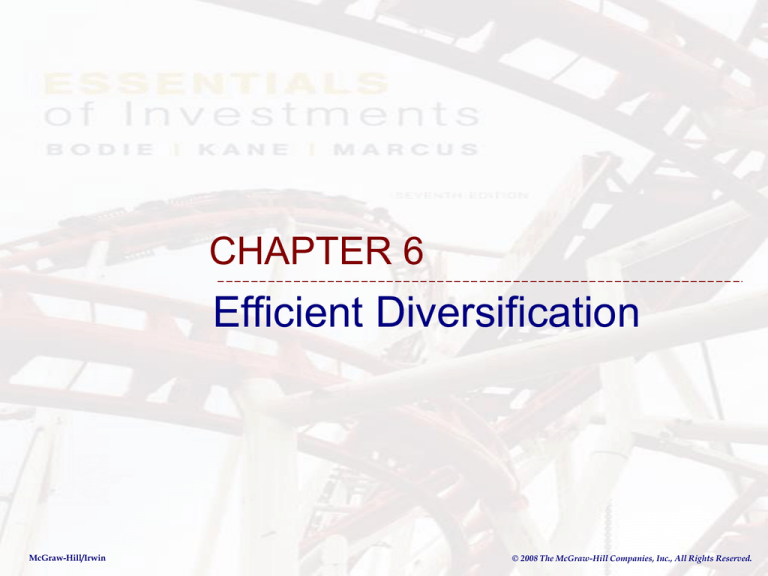
CHAPTER 6
Efficient Diversification
McGraw-Hill/Irwin
© 2008 The McGraw-Hill Companies, Inc., All Rights Reserved.
6.1 DIVERSIFICATION AND
PORTFOLIO RISK
6-2
Diversification and Portfolio Risk
Market risk
– Systematic or Nondiversifiable
Firm-specific risk
– Diversifiable or nonsystematic
6-3
Figure 6.1 Portfolio Risk as a
Function of the Number of Stocks
6-4
Figure 6.2 Portfolio Risk as a
Function of Number of Securities
6-5
6.2 ASSET ALLOCATION WITH
TWO RISKY ASSETS
6-6
Covariance and Correlation
Portfolio risk depends on the correlation
between the returns of the assets in the
portfolio
Covariance and the correlation coefficient
provide a measure of the returns on two
assets to vary
6-7
Two Asset Portfolio
Return – Stock and Bond
6-8
Covariance and Correlation Coefficient
Covariance:
S
Cov(rS , rB ) p(i ) rS (i ) rS rB (i ) rB
i 1
Correlation
Coefficient:
SB
Cov(rS , rB )
S B
6-9
Correlation Coefficients:
Possible Values
Range of values for 1,2
-1.0 < < 1.0
If = 1.0, the securities would be
perfectly positively correlated
If = - 1.0, the securities would be
perfectly negatively correlated
6-10
Two Asset Portfolio Std. Dev. –
Stock and Bond
rp wB rB wS rS
E ( rp ) wB E ( rB ) wS E ( rS )
E [( rp E ( rp )) 2 ] E [{( wB [ rB E ( rB )] wS [ rS E ( rS )]} 2 ]
E{wB2 [ rB E ( rB )] 2 wS2 [ rS E ( rS )] 2 2 wB wS [ rB E ( rB )][ rS E ( rS )]}
wB2 E{[ rB E ( rB )] 2 } wS2 E{[ rS E ( rS )] 2 } 2 wB wS E{[ rB E ( rB )][ rS E ( rS )]}
p2 Var( rp ) wB2 B2 wS2 S2 2 wB wS Cov( rB , rS )
wB2 B2 wS2 S2 2 wB wS B ,S B S
Portfolio Variance
Portfolio Standard Deviation
2
p
2
p
6-11
In General, For an n-Security Portfolio:
rp = Weighted average of the
n securities
p2 = (Consider all pair-wise
covariance measures)
6-12
Three ‘Rules’ of Two-Risky-Asset Portfolios
Rate of return on the portfolio:
rP wB rB wS rS
Expected rate of return on the portfolio:
E (rP ) wB E (rB ) wS E (rS )
6-13
Three ‘Rules’ of Two-Risky-Asset Portfolios
Variance of the rate of return on the portfolio:
( wB B ) ( wS S ) 2( wB B )( wS S ) BS
2
P
2
2
6-14
Numerical Text Example: Bond and Stock
Returns (Page 169)
Returns
Bond = 6% Stock = 10%
Standard Deviation
Bond = 12% Stock = 25%
Weights
Bond = .5
Stock = .5
Correlation Coefficient
(Bonds and Stock) = 0
6-15
Numerical Text Example: Bond and Stock
Returns (Page 169)
Expected Return = .08 = 8%
=.5(0.06) + .5 (0.10)=0.08
Standard Deviation = .1387=13.87%
=[(.5)2 (0.12)2 + (.5)2 (0.25)2 +
2 (.5) (.5) (0.12) (0.25) (0)] ½
=[1.9225]1/2 = .1387 = 13.87%
6-16
Figure 6.3 Investment Opportunity
Set for Stocks and Bonds
6-17
Figure 6.4 Investment Opportunity Set for
Stocks and Bonds with Various Correlations
6-18
6.3 THE OPTIMAL RISKY PORTFOLIO
WITH A RISK-FREE ASSET
6-19
Extending to Include Riskless Asset
The optimal combination becomes linear
A single combination of risky and riskless
assets will dominate
6-20
Figure 6.5 Opportunity Set Using Stocks
and Bonds and Two Capital Allocation Lines
6-21
Dominant CAL with a Risk-Free
Investment (F)
CAL(O) dominates other lines -- it has the best
risk/return or the largest slope
Slope =
E (rA ) rf
A
6-22
Dominant CAL with a Risk-Free
Investment (F)
E (rP ) rf
P
E (rA ) rf
A
Regardless of risk preferences, combinations of
O & F dominate
6-23
Figure 6.6 Optimal Capital Allocation Line
for Bonds, Stocks and T-Bills
6-24
Optimal Allocation
We want to maximize the Sharpe ratio –
the ratio of the expected return to risk for
the complete portfolio risk
The complete portfolio is the portfolio that
is a combination of one of our risky asset
portfolios (in our portfolio choice set) and
the risk free asset.
The highest Sharpe ratio is for the CAL
just tangent to the portfolio choice set
6-25
Optimal Allocation
Maximizing the Sharpe Ratio:
6-26
Figure 6.7 The Complete Portfolio
6-27
Figure 7.8 Determination of the Optimal
Overall Portfolio
6-28
Figure 6.8 The Complete Portfolio –
Solution to the Asset Allocation Problem
6-29
6.4 EFFICIENT DIVERSIFICATION WITH
MANY RISKY ASSETS
6-30
Three-Security Portfolio
E (rp ) w1E (r1 ) w2 E (r2 ) w3 E (r3 )
2p = w1212 + w2212 + w3232
+ 2w1w2
Cov(r1,r2)
+ 2w1w3 Cov(r1,r3)
+ 2w2w3 Cov(r2,r3)
6-31
Extending Concepts to All Securities
The optimal combinations result in lowest
level of risk for a given return
The optimal trade-off is described as the
efficient frontier
These portfolios are dominant
6-32
Figure 6.9 Portfolios Constructed from
Three Stocks A, B and C
6-33
Figure 6.10 The Efficient Frontier of Risky
Assets and Individual Assets
6-34
Portfolio Choice Set – Minimum
Variance
Finding the minimum variance portfolio:
6-35
Investment Opportunity Set for Bond and
Stock Funds
6-36
Optimal Allocation
We want to maximize the Sharpe ratio –
the ratio of the expected return to risk for
the complete portfolio risk
The complete portfolio is the portfolio that
is a combination of one of our risky asset
portfolios (in our portfolio choice set) and
the risk free asset.
The highest Sharpe ratio is for the CAL
just tangent to the portfolio choice set
6-37
6.5 A SINGLE-FACTOR ASSET MARKET
6-38
Single Factor Model
Ri E ( Ri ) i M ei
βi = index of a securities’ particular return to the
factor
M = unanticipated movement commonly related to
security returns
Ei = unexpected event relevant only to this
security
Assumption: a broad market index like the
S&P500 is the common factor
6-39
Specification of a Single-Index Model of
Security Returns
Use the S&P 500 as a market proxy
Excess return can now be stated as:
Ri i RM e
– This specifies the both market and firm risk
6-40
Figure 6.11 Scatter Diagram for Dell
6-41
Figure 6.12 Various Scatter Diagrams
6-42
Components of Risk
Market or systematic risk: risk related to the
macro economic factor or market index
Unsystematic or firm specific risk: risk not
related to the macro factor or market index
Total risk = Systematic + Unsystematic
6-43
Measuring Components of Risk
i2 = i2 m2 + 2(ei)
where;
i2 = total variance of firm i
i2 m2 = systematic variance
2(ei) = unsystematic variance
6-44
Examining Percentage of Variance
Total Risk = Systematic Risk + Unsystematic
Risk
Systematic Risk/Total Risk = i2
(ßi2 m2 )/ i2 = i2
(i2 m2 )/[i2 m2 + 2(ei)] = i2
6-45
Advantages of the Single Index Model
Reduces the number of inputs for
diversification
Easier for security analysts to specialize
6-46
6.6 RISK OF LONG-TERM INVESTMENTS
6-47
Are Stock Returns Less Risky in the Long
Run?
Consider a 2-year investment
Variance of the 2-year return is double of that of the
one-year return and σ is higher by a multiple of the
square root of 2
6-48
Are Stock Returns Less Risky in the Long
Run?
Generalizing to an investment horizon of n
years and then annualizing:
6-49
The Fly in the ‘Time Diversification’
Ointment
Annualized standard deviation is only appropriate
for short-term portfolios
Variance grows linearly with the number of years
Standard deviation grows in proportion to
6-50
The Fly in the ‘Time Diversification’
Ointment
To compare investments in two different
time periods:
– Risk of the total (end of horizon) rate of return
– Accounts for magnitudes and probabilities
6-51







